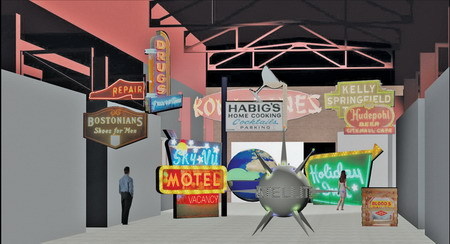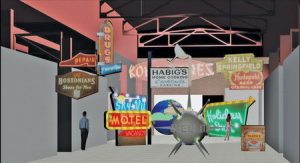I’ve compiled a “wish list” of the types of signs and sign-related objects the American Sign Museum is looking for, hoping that readers may be doing a little spring cleaning and discover some of these items and donate them.
Visitors repeatedly ask how we decide what items we accept. In response, I generally outline the museum’s goal for its collection: “I want to collect as many types of signs and sign-related items, from as many parts of the country and from as many different time periods, representing as many different sign companies and comprising as many different types of materials, as possible.” In short, I want the museum to offer a representative sampling of objects that captures the history of signmaking and sign design.
In the beginning, I wasn’t very picky – I was glad to acquire anything. Because the response throughout the museum’s first decade has been very positive, I’m now more discerning about what items we accept. But, some admitted “holes” exist in the collection, and these comprise the “wish list.”
Handlettering is, ironically, such a need. Early handlettered signs on wood, tin or even showcard board and chipboard are lacking. However, we have a fine, representative collection of goldleaf on glass. Although we have a wonderful collection of Las Vegas showcards from Bob Harper’s hand, we’d like to see more from other artists of earlier periods and from different parts of the country.
Early banners or other types of cloth signs are a real void, whereas we have several, early-1900s smalt signs (some on tin and some on wood). I’m also looking for simply painted signs, from one of my favorite periods – the 1920s and ’30s. Of course, some mainstays of the signpainter’s repertoire, such as truck lettering and walls, are inherently problematic: How do you find old truck doors intact, or take down and re-piece together a brick ghost sign?
Salesman’s samples are a personal favorite. We have some really great ones – from flip-ad neon clocks to edgelit, reverse-glass POP signs, and porcelain-enamel color samples to Raymond LeBlanc’s gilded glass panels – but we could use more.
Advertisement
I’m a sucker for signs still in their original crates, signs that have never been installed. We’ve already designated a corner of the existing museum to display a sampling of roughly eight such signs – about half the total of 15 presently in the collection. I prize such “NOS” signs, especially when they have shipping labels or other designations as to their origin. I plan to reserve an even larger space for such treasures in the new home.
Another category of needed items are sign artwork/sketches and 3-D models (for sales presentations). We particularly need airbrushed-on-black-card-stock designs of the 1930s to 1950s. These sketches were an art form all their own. As for architectural models, we have a very nice collec¬tion of models created by Douglas Leigh of Times Square fame, but we could certainly augment these with those from sign companies.
We’re also looking for items that can be grouped under “advertising specialties” – the promotional giveaways from sign companies, distributors, sign-product manufacturers and sign associations. Look around for lighters, yardsticks, ashtrays, pens and pencils, calendars, etc., and also the many other forms of giveaways.
Lastly, we’re always interested in photos and brochures/catalogs. These help us document the other items that comprise the collection, and they serve as historical reference for researchers.
I’ve listed a few of the “needs” we have, but this is by no means an exhaustive list. We are always looking for signs of all sorts and related items. Don’t hesitate to call (513) 258-4020, or email tod@signmuseum.org with your query. Thanks to all who’ve already made in-kind donations. Remember: Donations are tax-deductible.
Advertisement


 Tip Sheet3 days ago
Tip Sheet3 days ago
 Business Management2 weeks ago
Business Management2 weeks ago
 Women in Signs2 weeks ago
Women in Signs2 weeks ago
 Real Deal4 days ago
Real Deal4 days ago
 Editor's Note1 week ago
Editor's Note1 week ago
 Benchmarks15 hours ago
Benchmarks15 hours ago
 Line Time2 weeks ago
Line Time2 weeks ago
 Product Buying + Technology1 week ago
Product Buying + Technology1 week ago











